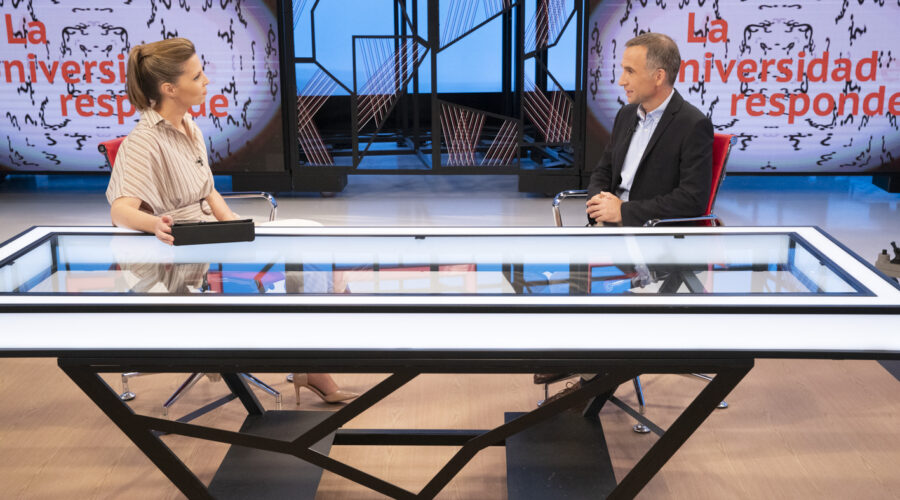IMDEA Networks

Albert Banchs habla sobre el presente y futuro de 5G en ‘La Aventura del Saber’
Un encuentro con un clásico de la divulgación de TVE, para hablar sobre los avances en esta tecnología y otros aspectos relacionados con las telecomunicaciones
18 Junio 2021

Albert Banchs, director de IMDEA Networks Institute y catedrático de Ingeniería Telemática en la Universidad Carlos III de Madrid, fue entrevistado en el programa de La 2 ‘La Aventura del Saber’, todo un clásico de la televisión pública española, redifundido, además por el Canal Internacional de TVE. Desde 1992, el programa (fruto de un convenio de colaboración entre el Ministerio de Educación y RTVE) se emite de lunes a viernes (de 10 a 11 am) para proponer a los espectadores todo tipo de contenidos relacionados con la cultura, la ciencia, la tecnología, el medio ambiente, etc., tanto con reportajes como con entrevistas en plató.
Banchs conversó con Mara Pettersen, copresentadora del espacio junto a su director, Salvador Gómez Valdés, sobre el presente y proyección de la tecnología 5G. Comenzó destacando cómo la nueva generación de telefonía móvil, “revoluciona toda la arquitectura de red, como un nuevo paradigma, no solo para satisfacer requisitos muy extremos en términos de velocidad de datos, sino también en otras métricas, como la latencia, la fiabilidad o la densidad de dispositivos. Para ello, utilizamos la tecnología de virtualización, convergiendo con el ‘cloud computing’ y con una sustitución del hardware específico de comunicación 4G con plataformas computacionales de propósito general que ejecutan la funcionalidad de red mediante software (muchísima más fiabilidad y eficiencia y, lo más importante, personalización de instancias de la red con el ‘network slicing’”.
Un nuevo escenario que, como se comentó durante la entrevista, permitirá que los usuarios puedan acceder a servicios y aplicaciones con mayor profundidad que los propios de 4G: “coches autoconducidos, realidad virtual y aumentada, el ‘internet táctil’, etc.”. “Más allá del propio usuario (señaló Banchs), otro de los objetivos es llegar a sectores económicos, los ‘sectores verticales’ que, hasta ahora, no utilizaban la red en toda su dimensión. En este sentido, trabajamos con un hospital en Francia, con el SAMUR en Madrid, con control de robots, en los aeropuertos de Hamburgo y Atenas, un museo en Italia… todos pueden beneficiarse de las ventajas del 5G”.
Cambio tecnológico, cambio social
La charla supuso una reflexión sobre la influencia de la tecnología en la sociedad (cómo nos comunicamos, trabajamos, nos desplazamos, etc.), un entorno en el que Banchs destacó casos concretos: “Por ejemplo, una ‘camiseta inteligente’ nos permitirá monitorizar en tiempo real nuestra salud y, en su caso, comunicarnos con los especialistas”. Y también señaló que, aparte de nuestra comunicación con los objetos, los propios objetos estarán conectados entre ellos: “Para ello, hay que sustituir los elementos, las estaciones base y en la parte troncal, central de la red, el ‘core’, que suponen inversiones a rentabilizar y llevarán cierto tiempo”. Elementos que, de momento, y como transición, reutilizan las infraestructuras de 4G, en el modo denominado Non-Standalone.
Banchs destacó cómo España se encuentra en una buena situación para este despliegue, sobre todo en las grandes ciudades: “Es importante la cobertura de un 80% de la población con red fija, de fibra óptica, de hecho, la red de telecomunicaciones, ha soportado bien el incremento de un 30% de uso… imagine este incremento en el tráfico o en el consumo eléctrico”. Y, para terminar, dedicó unas palabras a la privacidad de datos en internet, otro de los objetos de estudio por parte de los investigadores de IMDEA Networks Institute: “A pesar de una legislación europea y garantista en este sentido, es muy difícil controlarla, por la complejidad tecnológica, los intereses comerciales, etc. Hacemos estudios continuamente que demuestran cómo más de un 90% de aplicaciones filtran datos personales, incluso las preinstaladas en nuestros móviles, que podíamos presumir que eran más seguras”.



Comentarios recientes